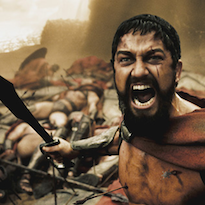Like many things in the fitness industry, the mantra “no pain, no gain” has been misused and misrepresented. Has the mantra provided trainers and instructors with a license to kill? Has it become a means to an unknowledgeable end? Has the mantra set an unrealistic and unhealthy expectation for its victims?
One Person’s Pain is Another Person’s Insane
Often the answer lies in the definition and implementation. What is this pain you speak of? For the beginner, the frail, or the untrained, it is the strain of the first deep breath. For the elite, the powerful, or the athletic titans, it is wielding to the muscle-tearing edge. That is quite the spectrum for those who stroll unknowingly into their local fitness club in hopes of finding their long lost reflection.
A finger of blame for this skewing of definition can be directed at fitness marketing, where functional has become fanatical and exercise described as epic. The sensationalizing of fitness has left many confused or misled. How much pain are we talking about here? If I take pain out of the equation, am I forfeiting the gains? No excuses.
Painstakingly Irresponsible
Is there a time when a person should be pushed to his or her limits? Absolutely. Can healthy physical pain result from the proper implementation of training? Yes. Is this level of intensity required? Does this level of extreme constitute the majority of a person’s program? More specifically, in the scope of group fitness, what percentage of exercise insanity should exist? During my own training, I have been known to bury myself, destroy my limits, push beyond ability, suffer, and dance with failure (“…are you not entertained?”…that’s a left-field reference from Gladiator). I made my personal training exploits appear quite epic, didn’t I? The reality is that I’ve been training as a competitive athlete for over 20 years. It would be fair to say that 90% of my training has not included the odor of pain, yet each year I’ve been satisfied with real measurable gains.
[Tom steps up on soap box.] As a fitness professional, it ticks me off when I see others flying the “no pain, no gain” flag without providing context. Should one build up to this high expectation of training? Does maximum intensity provide the best results for everyone in all demographics? Is it appropriate and responsible for the group fitness hoards? Unfortunately, knowledge is boring compared to a quivering six-pack.
Want vs. Need
Want vs. need is a fine line in most circumstances, but in the fitness industry the two have been molded into one. Posters and commercials for exercise programs and equipment have become hard to distinguish from those of action-adventure movies. Gym- and movie-goers alike drool over what they believe is needed to release their glistening Adonis or Adonisette in the upcoming year. Let’s face it, who is really going to be attracted to a sensible training program, continually and consistently performed for long-term results, when the “Master-X Hyper Program, 5 Insane Minutes/Day to Maximum Results” taunts from the billboard on the club across the street? It is so extreme. Look at how gorgeous their bodies are! Isn’t it wonderful?
Real Pain, Real Gain.
Does gain require pain? To some degree it does, but it depends on how each person defines it. Discomfort may very well be what most in our group fitness classes experience. Discomfort when breathing, when muscles are faltering, or when coaxed beyond our mind’s tolerance. Honestly, discomfort is what most elite athletes frequently experience when training, not actual pain. Discomfort is just not that sexy a word. It conjures up thoughts of digestive remedies, not feats of athletic heroism. So amidst the noise and confusion, we still need to do our best to give those in our care the most effective workout, based on sound training concepts, to deliver the desired results.
Chant it from the rooftops, “No Discomfort, No Attainment!”
For additional insight, read Jennifer Sage’s discussion of No Pain No Gain.


Thank you, Tom, for this excellent article. I have some “no pain, no gain” riders in my classes. I explain pain vs discomfort to them, yet there are those who still feel a successful ride is one that leaves them unable to walk. I am happy to find a new phrase of encouragement,” No discomfort, no attainment.”
Great article, thanks Tom